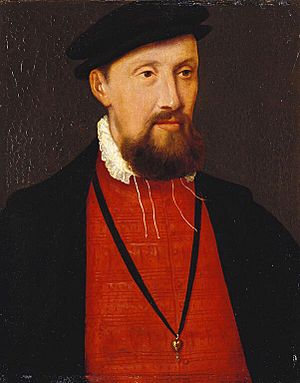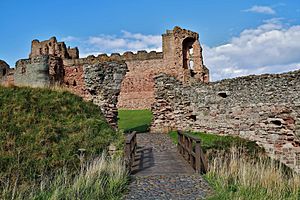Archibald Douglas, 6th Earl of Angus facts for kids
Quick facts for kids
Archibald Douglas
|
|
|---|---|
 |
|
| Born | c. 1489 Douglasdale, Lanarkshire, Scotland |
| Died | 22 January 1557 Tantallon Castle, Scotland |
| Resting place | Abernethy |
| Tenure | 1513–1557 |
| Nationality | Scottish |
| Offices | Lord Chancellor of Scotland |
| Spouse(s) | Margaret or Mary Hepburn Margaret Maxwell |
| Issue | |
| Parents |
|
|
|
|
Archibald Douglas, 6th Earl of Angus (around 1489 – 22 January 1557) was a very important Scottish nobleman. He lived during the reigns of King James V and Mary, Queen of Scots.
Archibald became the Earl of Angus after his grandfather died. His father had been killed in a big battle called the Battle of Flodden. Through his daughter, Margaret, Archibald was the grandfather of Henry Stuart, Lord Darnley. This means he was also the great-grandfather of James VI and I, who became King of both Scotland and England.
Archibald Douglas: A Powerful Scottish Noble
Marriage to Queen Margaret Tudor
In 1514, Archibald Douglas married Margaret Tudor. She was the widow of King James IV and the mother of the young King James V. Margaret was also the older sister of Henry VIII of England.
This marriage made some Scottish nobles unhappy. They worried about England's influence in Scotland. A civil war began, and Margaret lost her role as the young king's regent (a person who rules for a child king).
Archibald tried to make peace with the new regent, John Stewart, Duke of Albany. Margaret Tudor returned to Scotland later, hoping to get her power back. But Archibald had started a relationship with another woman and had a daughter with her. He also took some of Margaret's money and property. Margaret was very upset by this.
Margaret then tried to get a divorce from Archibald. When Albany returned to Scotland in 1521, Margaret sided with him against her husband. Archibald was accused of being disloyal to the king. He was sent to France as a prisoner but managed to escape to London in 1524.
Becoming a Lord of the Articles
Archibald returned to Scotland in November 1524. He had promises of support from King Henry VIII. Margaret, however, did not want anything to do with him.
In February 1525, Archibald gathered many nobles who supported him. They entered Edinburgh and held a parliament. Archibald was made a Lord of the Articles. This meant he helped decide what laws would be discussed. He also joined the council that helped rule the country. For a while, Archibald held a lot of power in Scotland.
Peace Treaty with England
In 1526, Archibald was put in charge of keeping order along the border with England. He signed a peace treaty with England on 10 October 1525. This treaty was meant to last for three years. It aimed to stop fighting and allow safe travel and trade. It also dealt with issues like cross-border robbery.
Guarding the Young King
In July 1526, Archibald was given the job of guarding the young King James V. This was supposed to be for a set time. But when the time was up, Archibald refused to give up the king. He took control of the government. He filled important jobs with members of his own family, the Douglases. Archibald himself became the Lord Chancellor of Scotland, a very powerful position. People said that "None that time durst strive against a Douglas."
King James Escapes
King James V, who was now fourteen, was not happy being controlled by Archibald. He was kept under close watch. Several attempts to free him failed. Archibald even defeated an army led by the Earl of Lennox that tried to free the king.
On 11 March 1528, Margaret Tudor finally got her divorce from Archibald. A few weeks later, King James V escaped from Archibald's control. He went to his mother, Margaret, and immediately declared that Archibald and all the Douglases were outlaws. They were forbidden from coming near the king.
Exile in England

Archibald strengthened his castle, Tantallon Castle. His lands were taken away, and he was declared a traitor. King James tried many times to capture Tantallon Castle but failed. Eventually, Archibald gave up the castle as part of a peace deal between England and Scotland. In May 1529, Archibald went to England to live. King Henry VIII gave him money and promised to help him get his lands back.
Archibald's brother, Sir George Douglas of Pittendreich, was also a very clever diplomat. He often helped Archibald with his plans involving England. George and their uncle, Archibald Douglas of Kilspindie, also had their lands taken away and went into exile.
King James V punished other Douglases who remained in Scotland. Archibald's sister, Janet, Lady Glamis, was accused of plotting against the king. She was found guilty and executed in Edinburgh in 1537. Archibald stayed in England until 1542. He even joined English attacks on Scotland. King James refused to let him return.
Return to Scotland
When King James V died in 1542, Archibald returned to Scotland. King Henry VIII had sent him to arrange a marriage between Mary, Queen of Scots, and his son, Edward VI. Archibald got his lands back and became a royal advisor.
In 1543, he successfully arranged a peace treaty and the marriage plan. That same year, he married Margaret Maxwell. Soon after, Archibald and the regent, Earl of Arran, had a disagreement. In April 1544, Archibald was captured and put in prison.
Breaking with England
Later in 1544, an English army attacked Scotland, even Archibald's lands. This made Archibald join the group that was against England. He was released from prison. Archibald promised to stay loyal to Mary, Queen of Scots. He also supported the idea of Mary marrying the French prince, the Dauphin.
In July 1544, he was put in charge of southern Scotland. He fought bravely and helped Scotland win a big victory over the English at Ancrum Moor in February 1545. After this victory, the King of France gave him a special award.
However, Archibald still secretly wrote to King Henry VIII of England. He also signed a document that canceled the marriage and peace treaty with England. In September 1547, he led the front line of the Scottish army at the Battle of Pinkie. This was a big defeat for Scotland, but Archibald still fought well.
Archibald continued to have secret talks with the English. In 1548, the English tried to capture him, but he escaped. He sailed from Tantallon Castle to Edinburgh.
Later Life and Death
Even under the rule of Mary of Guise, the queen regent, Archibald's powerful and ambitious nature caused problems for the government. In 1547, he officially gave up his earldom but immediately got it back. This was to make sure his family would inherit it.
Archibald's life was mostly about gaining power for himself and his family. He often put his family's interests before the needs of Scotland. He died in January 1557 at Tantallon Castle in Scotland. He was buried in Abernethy.
Children and Royal Grandchildren
With Margaret Tudor, Archibald had one surviving legitimate child, a daughter named Margaret. Margaret married Matthew Stewart, 4th Earl of Lennox. Their son was Henry Stuart, Lord Darnley, who became the second husband of Mary, Queen of Scots.
Archibald also had a daughter outside of marriage, named Janet Douglas. She died around 1552. Janet married Patrick Ruthven, 3rd Lord Ruthven and had several children. Archibald also had an illegitimate son, George Douglas, who became a bishop.
Since Archibald's only legitimate son died young, his nephew David became the next Earl of Angus.
Images for kids
See Also



